Translate this page into:
Soft tissue augmentation - Use of hyaluronic acid as dermal filler
Correspondence Address:
Maya Vedamurthy
W-171, Park Road, Annanagar, Western extension, Chennai - 600101
India
| How to cite this article: Vedamurthy M. Soft tissue augmentation - Use of hyaluronic acid as dermal filler. Indian J Dermatol Venereol Leprol 2004;70:383-387 |
Abstract
Soft tissue augmentation has revolutionized the treatment of the aging face. It is a technique in which a substance is injected under the skin. The concept of utilizing materials for soft tissue augmentation actually began around 1950 with the use of fluid silicone. Today we have a large armamentarium of implant materials to delay the tell tale signs of aging. Filling has replaced conventional surgery in facial rejuvenation. In this article, the emphasis will be on hyaluronic acid as this substance is easily available in India and ranks among the most widely used dermal fillers.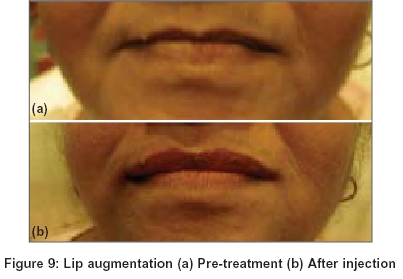 |
 |
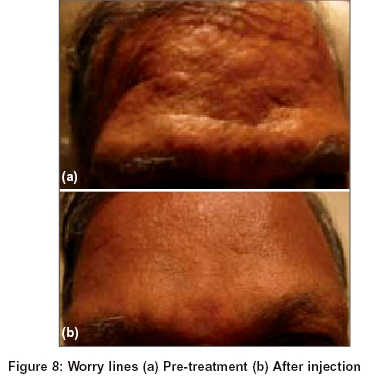 |
 |
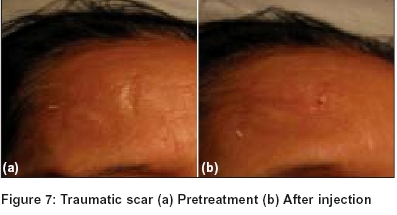 |
 |
 |
 |
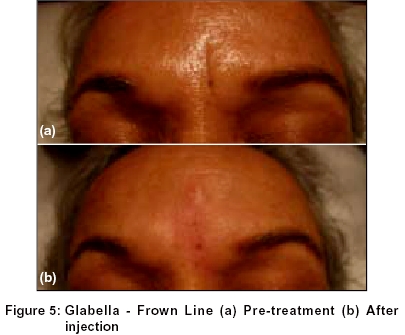 |
 |
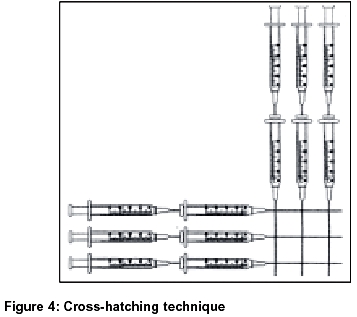 |
 |
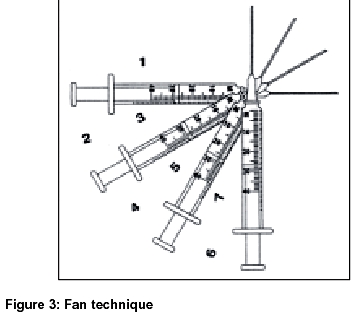 |
 |
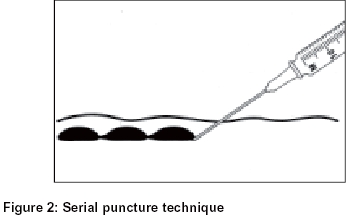 |
 |
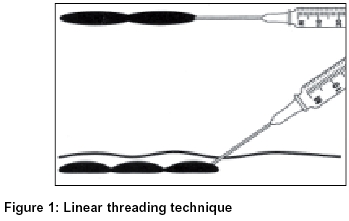 |
 |
HYALURONIC ACID - THE HISTORY
In 1934, Karl Meyer and his colleague John Palmer isolated a chemical substance from the vitreous jelly of cow′s eyes. They proposed the name hyaluronic acid as it was derived from hyaloid (vitreous) and contained two sugar molecules one of which was uronic acid. Hyaluronic acid was first used commercially in 1942 when Endre Balazs applied for a patent to use it as a substitute for egg white in bakery products.
STRUCTURE
Hyaluronic acid is a linear polysaccharide that exists naturally in all living organisms and is a universal component of the extra-cellular spaces of body tissues. The identical structure of hyaluronic acid in all species and tissues makes this polysaccharide an ideal substance for use as a bio-material in health and medicine.
DISTRIBUTION OF HYALURONIC ACID IN THE BODY
Hyaluronic acid is present in many places in the human body. It gives volume to the skin, shape to the eyes and elasticity to the joints. The highest concentrations are found in connective tissues, and most hyaluronic acid (about 56%) is found in the skin.
PRODUCTS OF HYALURONIC ACID
Restylane , Perlane
Traditionally hyaluronic acid has been extracted from animal sources. The hyaluronic acid in Restylane and Perlane is biosynthetically produced by bacterial fermentation. Apart from ethical issues of using animals for esthetic purposes, it has the advantage of being free from the risk of transmitting diseases between species or eliciting allergic reactions in patients who are sensitive to common foods such as beef, chicken and eggs.
Dermalive
This contains 14.5% hyaluronic acid and molecules of a hydrophilic gel (Hydro-ethyl-methacrylate, HEMA). It is a product with a crystalline, milky gel appearance that consists of non-animal, stabilized hyaluronic acid.
Hyalaform
Also known as Hylan B gel, it is processed from the coxcombs of domestic fowl. Since it has an avian origin, it should not be used in patients with known allergy to substances of avian origin.
Ac Hyal
This is a 1% solution of the sodium salt of hyaluronic acid. It is a Japanese product and is available in Europe. There are no references to its use in the literature.
Hylan Rofilan Gel
This is a hyaluronic acid cross-linked with a natural acid instead of a chemical compound.
Reviderm - Intra
This contains 40-60 m dextran beads of the sephadex type in hylan gel. It is non-animal in origin. The material is non-immunogenic, biocompatible and biodegradable.
All the above substances are available in pre-filled syringes together with suitable needles for injection.
INDICATIONS OF DERMAL FILLERS
These include:
- Depressed scars: Post-surgical, traumatic, post-acne or other diseases
- Wrinkles and folds
- Lip sculpting
- Enhancement of facial contour
- Periocular melanoses and sunken eyes
CONTRAINDICATIONS
These include:
- Keloidal tendency
- Hypersensitivity to products as demonstrated by positive skin testing
- Unrealistic expectations
PREPARATION
A detailed clinical examination and history taking is mandatory. Counseling with regard to expectations and limitations of the product used is essential. A preoperative photograph and written informed consent are recommended.
Procedure
The patient′s need for anesthesia should be assessed. Normally no anesthesia is necessary when injecting for correction of wrinkles. If the patient requires anesthesia a topical anesthetic cream is applied to the area under occlusion at least one hour prior to the treatment.
The area to be treated is cleaned with a suitable antiseptic solution. The needle supplied with the syringe is fixed to the syringe and the product is injected into the skin.
TECHNIQUES OF INJECTION [Figure - 1], [Figure - 2], [Figure - 3], [Figure - 4]
1. Linear threading technique:
The full length of the needle is inserted in the middle of the wrinkle and the substance is injected while pulling the needle slowly backwards so that the threads of the gel are placed lengthwise in the wrinkle.
2. Serial puncture technique:
Multiple injections are placed serially along the length of the treated wrinkle/fold. It is made closely together so that it merges into a smooth continuous line which lifts the wrinkle.
3. Fan technique:
The needle is inserted at the periphery of the area to be treated as when using the linear threading technique. After injecting one line the direction of the needle is changed and injected as before along a new line.
4. Cross hatching technique:
The needle is inserted at the periphery of the area intended to be augmented and injected as when using the linear threading technique. The needle is withdrawn from the skin and inserted 5-10 nm adjacent to the first puncture site and injected in the same way. This procedure can then be repeated at right angles to the original lines.
SUCCESSFUL TREATMENT
Where to inject is the key to successful treatment. For best results the products should be injected within the recommended tissue depth, e.g. Perlane in the deep dermis, Restylane in the mid-dermis and Restylane fine lines in the upper dermis. [Figure - 5], [Figure - 6], [Figure - 7], [Figure - 8], [Figure - 9].
Post-treatment care
The area should not be touched for 6 hours after the injection, and should not be exposed to extreme heat or cold. Touch up treatment can be given after 2-4 weeks if necessary.
COMBINATION APPROACH
- Sandwich procedure: Here a layering technique, where one product is injected above the other in different planes for a better esthetic effect, is followed,
ADVERSE EFFECTS
These could be injection related or substance related. Injection related adverse effects are more common, consisting of erythema, swelling, pain, itching, discoloration and tenderness at the implant site. Resolution is spontaneous within one or two days. Substance related adverse effects are rare (less than 1 in 2000 treatments). They are thought to be of a hypersensitive nature and consist of swelling and induration at the implant site. A short course of oral steroids or intralesional hyaluronidase may be needed. A case of arterial embolization following the injection of dermal filler in the glabella area has also been reported.[4]
CONCLUSION
Fillers are a practical and instant solution relatively free of side effects for patients who wish to look young without undergoing major surgical procedures. However the effects of fillers like hyaluronic acid are temporary and injections need to be repeated once in 6-10 months. The search for a perfect material to eradicate rhytides, smooth scars and fill traumatic defects continues.
| 1. |
Naoum C, Dasiou - Plakida D. Dermal filler materials and botulin toxin. Int J Dermatol 2001;40:609-21.
[Google Scholar]
|
| 2. |
Lupton JR, Alsters TS. Cutaneous hypersensitivity reaction to injectable hyaluronic acid gel. Dermatol Surg 2000;26:135-7.
[Google Scholar]
|
| 3. |
Henry H. Roenigk Jr. Treatment of the aging faces. In: Roenigk and Roenigk's Dermatologic surgery - Principles and practice - 2nd Ed, New York: Marcel Dekker; 1996;59:1057-76.
[Google Scholar]
|
| 4. |
Schanz S, Schippert W, Ulmer A, Rassner G, Fierlbeck G. Arterial embolisation caused by injection of hyaluronic acid (Restylane). Br J Dermatol 2002;146:928-9.
[Google Scholar]
|
Fulltext Views
4,659
PDF downloads
1,650





